Applies ToWindows 8.1 Windows Server 2012 R2 Windows Embedded 8.1 Industry Enterprise Windows Embedded 8.1 Industry Pro
Version:
Windows 8.1, Windows Server 2012 R2, Windows Embedded 8.1 Industry Enterprise, Windows Embedded 8.1 Industry Pro
Learn all about the security and non-security updates that are published for Windows 8.1 and Windows Server 2012 R2 through Windows Update. These updates address issues and improve the overall reliability of the operating system.
Windows 8.1 and Windows Server 2012 R2 rollups (monthly rollups and security-only updates) are applicable by default to the following Windows 8.1 Industry-based embedded product:
-
Windows Embedded 8.1 Industry Enterprise.
-
Windows Embedded 8.1 Industry Pro.
If a rollup is not applicable to an embedded product, we will explicitly state that it is not applicable.
On the left side of this page, there is a reference to all of the updates that have been released for this version of Windows. We recommend installing all updates for Windows that are available for your device. Installing the most recent update means you get all of the previous updates, as well, including important security fixes.
Current status of Windows 8.1 and Windows Server 2012 R2
For the most up-to-date information about Known Issues for Windows and Windows Server, please go to the Windows release health dashboard.
Notes and messages
General
IMPORTANT Starting in July 2020, all Windows Updates will disable the RemoteFX vGPU feature because of a security vulnerability. For more information about the vulnerability, seeCVE-2020-1036 and KB4570006. After you install this update, attempts to start virtual machines (VM) that have RemoteFX vGPU enabled will fail, and messages such as the following will appear:
If you re-enable RemoteFX vGPU, a message similar to the following will appear:
-
“The virtual machine cannot be started because all the RemoteFX-capable GPUs are disabled in Hyper-V Manager.”
-
“The virtual machine cannot be started because the server has insufficient GPU resources.”
-
«We no longer support the RemoteFX 3D video adapter. If you are still using this adapter, you may become vulnerable to security risk. Learn more (https://go.microsoft.com/fwlink/?linkid=2131976)”
Related info
-
Windows Update: FAQ
-
Windows Server 2012 update history
-
Windows 7 SP1 and Windows Server 2008 R2 SP1 update history
-
Windows Server 2008 SP2 update history
-
Get Windows 10
Need more help?
Want more options?
Explore subscription benefits, browse training courses, learn how to secure your device, and more.
Applies ToWindows Server 2012 Windows Embedded 8 Standard
Version:
Windows Server 2012
Learn all about the security and non-security updates that are published for Windows Server 2012 through Windows Update. These updates address issues and improve the overall reliability of the operating system.
On the left side of this page, there is a reference to all of the updates that have been released for this version of Windows. We recommend installing all updates for Windows that are available for your device. Installing the most recent update means you get all of the previous updates, as well, including important security fixes.
Current status of Windows Server 2012
For the most up-to-date information about Known Issues for Windows and Windows Server, please go to the Windows release health dashboard.
Notes and messages
General
IMPORTANT Starting in July 2020, all Windows Updates will disable the RemoteFX vGPU feature because of a security vulnerability. For more information about the vulnerability, seeCVE-2020-1036 and KB4570006. After you install this update, attempts to start virtual machines (VM) that have RemoteFX vGPU enabled will fail, and messages such as the following will appear:
If you re-enable RemoteFX vGPU, a message similar to the following will appear:
-
“The virtual machine cannot be started because all the RemoteFX-capable GPUs are disabled in Hyper-V Manager.”
-
“The virtual machine cannot be started because the server has insufficient GPU resources.”
-
«We no longer support the RemoteFX 3D video adapter. If you are still using this adapter, you may become vulnerable to security risk. Learn more (https://go.microsoft.com/fwlink/?linkid=2131976)”
As of February 11, 2020, Internet Explorer 10 is no longer in support. To get Internet Explorer 11 for Windows Server 2012 or Windows 8 Embedded Standard, see KB4492872. Install one of the following applicable updates to stay updated with the latest security fixes:
-
Cumulative Update for Internet Explorer 11 for Windows Server 2012.
-
Cumulative Update for Internet Explorer 11 for Windows 8 Embedded Standard.
-
The November 2020 Monthly Rollup.
Related info
-
Windows Update: FAQ
-
Windows 8.1 and Windows Server 2012 R2 update history
-
Windows 7 SP1 and Windows Server 2008 R2 SP1 update history
-
Windows Server 2008 SP2 update history
Need more help?
Want more options?
Explore subscription benefits, browse training courses, learn how to secure your device, and more.
Learn all about the security and non-security updates that are published for Windows 8.1 and Windows Server 2012 R2 through Windows Update. These updates address issues and improve the overall reliability of the operating system.
Windows 8.1 and Windows Server 2012 R2 rollups (monthly rollups and security-only updates) are applicable by default to the following Windows 8.1 Industry-based embedded product:
- Windows Embedded 8.1 Industry Enterprise.
- Windows Embedded 8.1 Industry Pro.
If a rollup is not applicable to an embedded product, we will explicitly state that it is not applicable.
On the left side of this page, there is a reference to all of the updates that have been released for this version of Windows. We recommend installing all updates for Windows that are available for your device. Installing the most recent update means you get all of the previous updates, as well, including important security fixes.
Windows 8.1 Windows Server 2012 R2 Windows Embedded 8.1 Industry Enterprise Windows Embedded 8.1 Industry Pro Больше…Основные параметры
Версия:
Windows 8.1, Windows Server 2012 R2, Windows Embedded 8.1 Industry Enterprise, Windows Embedded 8.1 Industry Pro
Здесь описаны все обновления (как связанные, так и не связанные с системой безопасности) для Windows 8.1 и Windows Server 2012 R2, опубликованные через Центр обновления Windows. Эти обновления предназначены для исправления ошибок в операционной системе, а также помогают повысить ее общую надежность.
Накопительные пакеты обновления для Windows 8.1 и Windows Server 2012 R2 (ежемесячные накопительные пакеты и обновления только для системы безопасности) применяются по умолчанию к следующим внедренным продуктам на основе Windows 8.1 Industry:
-
Windows Embedded 8.1 Industry Enterprise.
-
Windows Embedded 8.1 Industry Pro.
Если накопительное обновление не применимо к внедренному продукту, мы отдельно отметим, что оно не применимо.
В левой части страницы находится справочник по всем обновлениям, выпущенным для данной версии Windows. Мы рекомендуем устанавливать все обновления Windows, доступные для вашего устройства. Установка последнего обновления означает, что вы устанавливаете все предыдущие обновления, включая важные исправления системы безопасности.
Текущее состояние Windows 8.1 и Windows Server 2012 R2
Для получения самой последней информации об известных проблемах для Windows и Windows Server перейдите на панель мониторинга состояния выпуска Windows.
Примечания и сообщения
Общие
ВАЖНО! С июля 2020 г. во всех Центрах обновления Windows отключается функция RemoteFX vGPU из-за уязвимости в системе безопасности. Дополнительные сведения об этой уязвимости см. в CVE-2020-1036 и KB4570006. После установки этого обновления попытки запуска виртуальных машин (ВМ), в которых включена функция RemoteFX vGPU, будут завершаться сбоем и будут появляться следующие сообщения:
Если повторно включить функцию RemoteFX vGPU, появится следующее сообщение:
-
«Виртуальная машина не может быть запущена, так как все GPU с поддержкой RemoteFX отключены в диспетчере Hyper-V».
-
«Не удается запустить виртуальную машину, так как на сервере недостаточно ресурсов GPU».
-
«Видеоадаптер RemoteFX 3D больше не поддерживается. Если вы все еще используете этот адаптер, ваша безопасность под угрозой. Подробнее (https://go.microsoft.com/fwlink/?linkid=2131976)”
См. также
-
Центр обновления Windows: вопросы и ответы
-
Журнал обновлений Windows Server 2012
-
Журнал обновлений Windows 7 с пакетом обновления 1 (SP1) и Windows Server 2008 R2 с пакетом обновления 1 (SP1)
-
Журнал обновлений Windows Server 2008 с пакетом обновления 2 (SP2)
-
Переход на Windows 10
Нужна дополнительная помощь?
Though the purpose of Windows updates is to enhance the system performance, speed and security, sometimes that can create an issue too. It is very important to identify which updates were installed recently if you face issues with Windows OS or applications on your computer.
When you manage the server administration, you must take extra care while installing Windows updates. Some updates may cause problems with the installed applications or client-server setup. This guide explains where and how to view the installed updates/patches on your Windows 10/11 PC and Windows 2012 R2 (and the latest servers).
Checking the installed Windows update is not a tough task, but you may miss or confuse the place you must check since each interface on every Windows Operating System is different.
It can be checked in the control panel. That will show the details of updates with its KB number and date of installation.
1. To go to the ‘Windows Update’ settings, type ‘Update’ in the search. This will take you to the settings app on Windows 10 or 11. Click on ‘Windows Update settings’ as below.
2) On the next screen, click Advanced options to see the history of installed updates.
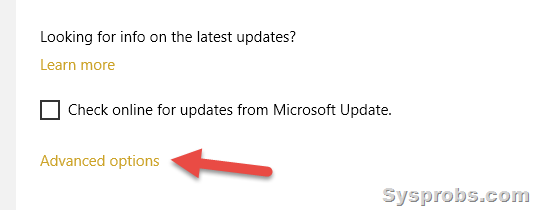
3) Click on ‘View your update history.’
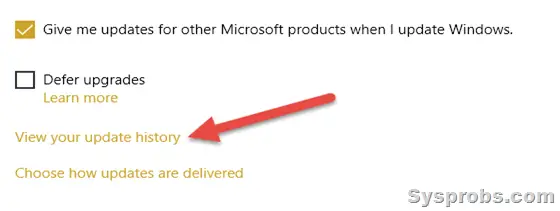
Here it will show the installed updates on your Windows 10 desktop or laptop computer.
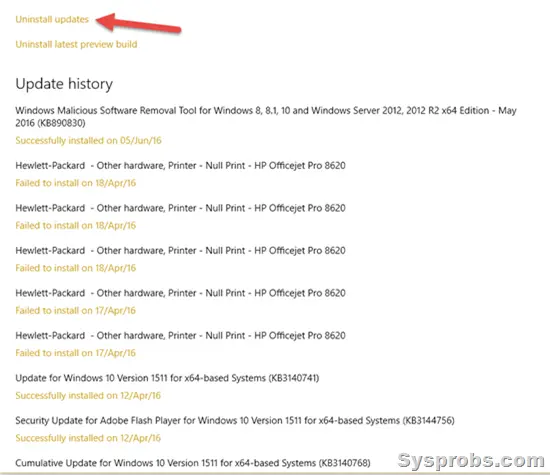
Few Drawbacks in this Method
- Unfortunately, this will not show all the updates on your computer. It shows the recent success or failure updates only.
- You can’t directly uninstall a specific update from this settings app; you have to click on ‘Uninstall updates, ’ which will take you to classic control panel settings.
Best Way to Check Installed Updates/Patches on Windows 10/11/2012 R2/2016/2019
Go to the classic (we call it ‘normal’) control panel and click on ‘Programs and Features’.
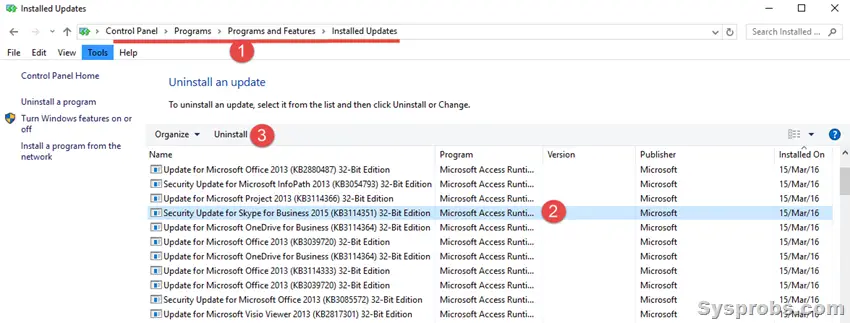
Here you can view the installed updates on the server or client Operating System with the installation date. It is easy to select individual installed updates and uninstall them (if you think that particular update is causing the issue on your computer or server).
View Windows Update Patches History in Command Prompt and PowerShell
We can use a few commands to check the Windows patch history in Windows client and Server Operating Systems. It is an ideal way to use when you connect a remote computer/server or in a Windows server core installation.
Open command prompt or Powershell and enter the below command to see the installed patches and hotfixes with the installation date in table format.
wmic qfe list full /format:table

If your computer has plenty of updates and you need to find the specific update, use the KB number in the below command.
wmic qfe | find “5007401”
Here is a similar PowerShell command:
Get-Hotfix

You can find more about each update and its implication by searching on Google or Microsoft websites for the particular KB number.
How to Remove a Windows Update from CLI?
It is possible to uninstall a particular Windows update/patch from the command prompt or PowerShell if you have administrative access.
Use one of the commands to find the installed updates and correct KB numbers, then execute the below command.
wusa /uninstall /kb:5010342
/quiet
/norestart
Those are additional keys you can use to uninstall without notifying the user and not restarting the computer or server.
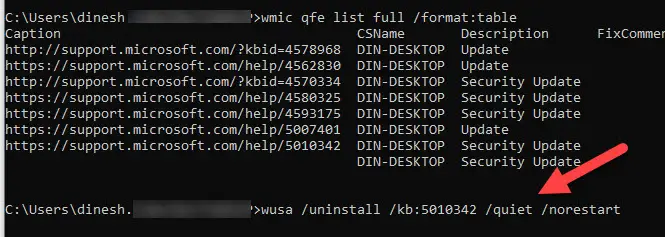
We hope this guide will be useful for finding out the installed Windows updates on Windows 10/11, 2012 R2 and any server Operating Systems.
